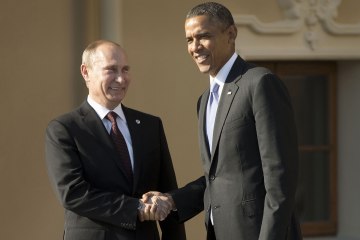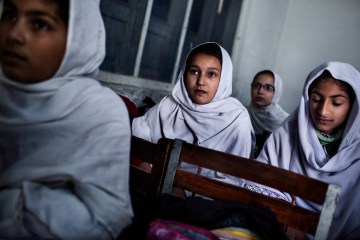On any given weekday morning, the streets of Mingora, Pakistan are thronged with schoolgirls on their way to class, dressed in the typical uniform of white loose trousers topped by a long colored tunic and white headscarf. They cram three abreast in tiny rickshaws, or pile into pick-up trucks that have been converted into schoolbuses, knees meeting in the central aisle as they face each other from benches welded down the length of each side. Such a scene makes it hard to believe that Mingora, the capital of Pakistan’s Swat district, is the epicenter of the fight for girls’ education. Not only that, it is home to the movement’s heroine, Malala Yousafzai, the 15-year-old schoolgirl who was shot in the head by the Taliban on October 9. After all, in 1922 the ruler of Swat, when it was an independent princely kingdomunder British colonial powers, made education compulsory for all children. Even after Swat was absorbed into Pakistan at independence, the legacy lingered: for decades, Swat had one of the highest literacy rates in what was then known as Pakistan’s North West Frontier Province. Last month the Pakistani government followed the example of that old ruler of Swat, and made education mandatory for all children between the ages of five and sixteen.
So why does girl’s education in Swat still need a champion?
The answer to that question called out to me late one afternoon as I strolled along the quiet alleyway that leads to Malala’s home. It was a middle class neighborhood, and all the houses were shielded from the street with high stone walls and imposing iron gates. Pashtuns, who make upmost of Swat’s population, don’t do sweeping front lawns. Instead, they hide their gardens, and their women, away from stranger’s eyes. Still, I could glimpse fruit-laden trees and tall pines peeking over the walls, tantalizing hints of what I assumed I would never see.
(MORE: The Other Girls on the Bus: How Malala’s Classmates Are Carrying On)
“Hello!” a voice called out from behind a thickly screened second-floor balcony. “How are you doing?” It was a girls’ voice, accented with the school-girl English I had grown accustomed to during my previous days’ visits to schools around Pakistan. The voice belonged to Aruj Khan, a 10th year student from Malala’s school, the Kushal School and College for girls, one of Swat’s many English-language private schools. The school was founded 17 years ago by Malala’s father, who believes that the solution to Pakistan’s problems lies in educating its women. Aruj recognized me from that morning, when I had attended the school assembly and a couple of classes. She invited me in for tea with her family.
We chatted in English for a while, sitting cross-legged on rope beds facing a lush green lawn fringed with ornamental shrubs and persimmon trees naked but for their heavy red fruits. I shared my faltering attempts at Pashto, while she and her mother giggled, trying to decipher my accent. Aruj’s sister, Saadia, served me a glass of rich buffalo milk tinted pink with a popular syrup here called Rooh Afza, a concoction of red fruits and rosewater perfumes.
(Person of the Year Runner-Up: Malala Yousafzai, the Fighter)
Aruj, who has two more years left of high school, told me that she wanted to be a doctor. Saadia had already graduated from high school. I asked Saadia what she did now that she had graduated. “Nothing,” she told me. “I wait around the house all day, it’s boring.” I asked if she was married. Not yet, though she is fiancéed. So is her cousin, who also lives in the familycompound. Both of them explained that there is nothing for them to do, so they wait for marriage and children to help fill the time.
So why don’t they go to for their bachelors’ degrees? I asked. They giggled, and hid their smiles behind their hands. Swat has no women’s university, they explained, so Khushal, and other girls’ high schools like it, are the last stop for the daughters of most conservative families. “We want girls universities,” Saadia told me. “Many girls are sitting at home because of this. There are only co-ed universities in Swat.” There is one women’s medical college in Peshawar, a three-hour drive away, but that is too far. Their conservative families won’t let them travel. “Our society will not let us go to co-educational colleges,” said Saadia. “So we can’t go to school anymore.”
(PHOTOS: Head Of Her Class: A Look at Malala’s School Work)
Aruj had already told me that her favorite class was biology (in fact, at Khushal, most of the girls told me the same). I asked her how she would become a doctor if she couldn’t go to the medical school in Swat. She looked unhappy, aware, perhaps, of a battle to come, one that she would certainly loose. “I want to go, but my father says no. Coeducational schools are not accepted in our society.“ There was an uncomfortable pause in the conversation, and Aruj stared at her lap.
So I asked the girls which would be better, bringing awomen’s university to Swat, or changing how society thinks? Aruj told me that it would be better to change society, because you would never be able to build enough girls universities. “Too many girls want to go for advanced degrees,” she said. “I don’t think anyone will have the money” to build them.
”You will never be able to change the mindset of people,” interjected Saadia. “It would be better to build more schools, so we all can have those opportunities.”
Aruj ricocheted back, “If every father is educated, it won’t be difficult.”
Saadia laughed. “We will put our father in school then.”
The girls’ mother listened in, smiling at their vivacious exchange, but she too seemed resigned to the fate of women in this compound. Aruj looked at her mother. “We need to educate fathers and mothers,” she said.
Her mother smiled at me and tried to explain. “It is our tradition that unmarried girls and boys don’t mix. We need to have girls’ universities so our girls can get the education they want. Otherwise it won’t be possible. Our society won’t allow it.”
I asked Aruj again how she was going to pursue her dreams of being a doctor, if this was the situation. This time she looked up, defiantly. “I don’t agree with my mother and my sister,” she said. “My opinion is different. If we educate our fathers, we can change their minds, and they will let us go to any school we like.”
Saadia had clearly heard this argument before. “You sound just like Malala,” she sighed. “Our father is not Malala’s father.”
Aruj smiled. “I like Malala,” she said. “She’s my friend. If we were all like Malala, we would all be going to university.”
Interactive Timeline: The Making of a Heroine


